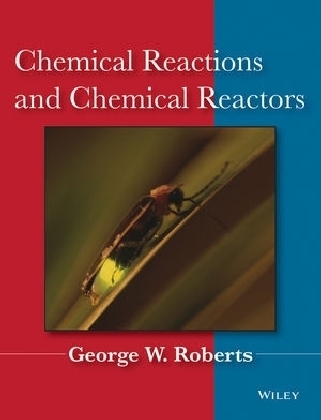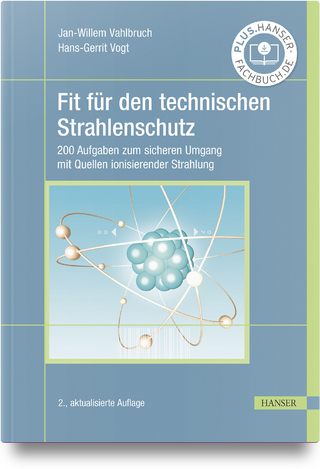
Chemical Reactions and Chemical Reactors
John Wiley & Sons Inc (Verlag)
978-0-471-74220-3 (ISBN)
Focused on the undergraduate audience, Chemical Reaction Engineering provides students with complete coverage of the fundamentals, including in-depth coverage of chemical kinetics. By introducing heterogeneous catalysis early in the book, the text gives students the knowledge they need to solve real chemistry and industrial problems. An emphasis on problem-solving and numerical techniques ensures students learn and practice the skills they will need later on, whether for industry or graduate work.
George W. Roberts is Professor of Chemical Engineering at North Carolina State University. He has also spent over 20 years in research and development with several industrial organizations in the Philadelphia area.
1. Reactions and Reaction Rates 1
1.1 Introduction 1
1.1.1 The Role of Chemical Reactions 1
1.1.2 Chemical Kinetics 2
1.1.3 Chemical Reactors 2
1.2 Stoichiometric Notation 3
1.3 Extent of Reaction and the Law of Definite Proportions 4
1.3.1 Stoichiometric Notation—Multiple Reactions 6
1.4 Definitions of Reaction Rate 8
1.4.1 Species-Dependent Definition 8
1.4.1.1 Single Fluid Phase 9
1.4.1.2 Multiple Phases 9
Heterogeneous Catalysis 9
Other Cases 10
1.4.1.3 Relationship between Reaction Rates of Various Species (Single Reaction) 10
1.4.1.4 Multiple Reactions 11
1.4.2 Species-Independent Definition 11
Summary of Important Concepts 12
Problems 12
2. Reaction Rates—Some Generalizations 16
2.1 Rate Equations 16
2.2 Five Generalizations 17
2.3 An Important Exception 33
Summary of Important Concepts 33
Problems 33
3. Ideal Reactors 36
3.1 Generalized Material Balance 36
3.2 Ideal Batch Reactor 38
3.3 Continuous Reactors 43
3.3.1 Ideal Continuous Stirred-Tank Reactor (CSTR) 45
3.3.2 Ideal Continuous Plug-Flow Reactor (PFR) 49
3.3.2.1 The Easy Way—Choose a Different Control Volume 51
3.3.2.2 The Hard Way—Do the Triple Integration 54
3.4 Graphical Interpretation of the Design Equations 54
Summary of Important Concepts 57
Problems 57
Appendix 3 Summary of Design Equations 60
4. Sizing and Analysis of Ideal Reactors 63
4.1 Homogeneous Reactions 63
4.1.1 Batch Reactors 63
4.1.1.1 Jumping Right In 63
4.1.1.2 General Discussion: Constant-Volume Systems 68
Describing the Progress of a Reaction 68
Solving the Design Equation 71
4.1.1.3 General Discussion: Variable-Volume Systems 74
4.1.2 Continuous Reactors 77
4.1.2.1 Continuous Stirred-Tank Reactors (CSTRs) 78
Constant-Density Systems 78
Variable-Density (Variable-Volume) Systems 80
4.1.2.2 Plug-Flow Reactors 82
Constant-Density (Constant-Volume) Systems 82
Variable-Density (Variable-Volume) Systems 84
4.1.2.3 Graphical Solution of the CSTR Design Equation 86
4.1.2.4 Biochemical Engineering Nomenclature 90
4.2 Heterogeneous Catalytic Reactions (Introduction to Transport Effects) 91
4.3 Systems of Continuous Reactors 97
4.3.1 Reactors in Series 98
4.3.1.1 CSTRs in Series 98
4.3.1.2 PFRs in Series 103
4.3.1.3 PFRs and CSTRs in Series 103
4.3.2 Reactors in Parallel 107
4.3.2.1 CSTRs in Parallel 107
4.3.2.2 PFRs in Parallel 109
4.3.3 Generalizations 110
4.4 Recycle 111
Summary of Important Concepts 114
Problems 114
Appendix 4 Solution to Example 4-10: Three Equal-Volume CSTRs in Series 122
5. Reaction Rate Fundamentals (Chemical Kinetics) 123
5.1 Elementary Reactions 123
5.1.1 Significance 123
5.1.2 Definition 125
5.1.3 Screening Criteria 126
5.2 Sequences of Elementary Reactions 129
5.2.1 Open Sequences 130
5.2.2 Closed Sequences 130
5.3 The Steady-State Approximation (SSA) 131
5.4 Use of the Steady-State Approximation 133
5.4.1 Kinetics and Mechanism 136
5.4.2 The Long-Chain Approximation 137
5.5 Closed Sequences with a Catalyst 138
5.6 The Rate-Limiting Step (RLS) Approximation 140
5.6.1 Vector Representation 141
5.6.2 Use of the RLS Approximation 142
5.6.3 Physical Interpretation of the Rate Equation 143
5.6.4 Irreversibility 145
5.7 Closing Comments 147
Summary of Important Concepts 147
Problems 148
6. Analysis and Correlation of Kinetic Data 154
6.1 Experimental Data from Ideal Reactors 154
6.1.1 Stirred-Tank Reactors (CSTRs) 155
6.1.2 Plug-Flow Reactors 156
6.1.2.1 Differential Plug-Flow Reactors 156
6.1.2.2 Integral Plug-Flow Reactors 157
6.1.3 Batch Reactors 158
6.1.4 Differentiation of Data: An Illustration 159
6.2 The Differential Method of Data Analysis 162
6.2.1 Rate Equations Containing Only One Concentration 162
6.2.1.1 Testing a Rate Equation 162
6.2.1.2 Linearization of Langmuir–Hinshelwood/Michaelis–Menten Rate Equations 165
6.2.2 Rate Equations Containing More Than One Concentration 166
6.2.3 Testing the Arrhenius Relationship 169
6.2.4 Nonlinear Regression 171
6.3 The Integral Method of Data Analysis 173
6.3.1 Using the Integral Method 173
6.3.2 Linearization 176
6.3.3 Comparison of Methods for Data Analysis 177
6.4 Elementary Statistical Methods 178
6.4.1 Fructose Isomerization 178
6.4.1.1 First Hypothesis: First-Order Rate Equation 179
Residual Plots 179
Parity Plots 180
6.4.1.2 Second Hypothesis: Michaelis–Menten Rate Equation 181
Constants in the Rate Equation: Error Analysis 184
Non-Linear Least Squares 186
6.4.2 Rate Equations Containing More Than One Concentration (Reprise) 186
Summary of Important Concepts 187
Problems 188
Appendix 6-A Nonlinear Regression for AIBN Decomposition 197
Appendix 6-B Nonlinear Regression for AIBN Decomposition 198
Appendix 6-C Analysis of Michaelis–Menten Rate Equation via
Lineweaver–Burke Plot Basic Calculations 199
7. Multiple Reactions 201
7.1 Introduction 201
7.2 Conversion, Selectivity, and Yield 203
7.3 Classification of Reactions 208
7.3.1 Parallel Reactions 208
7.3.2 Independent Reactions 208
7.3.3 Series (Consecutive) Reactions 209
7.3.4 Mixed Series and Parallel Reactions 209
7.4 Reactor Design and Analysis 211
7.4.1 Overview 211
7.4.2 Series (Consecutive) Reactions 212
7.4.2.1 Qualitative Analysis 212
7.4.2.2 Time-Independent Analysis 214
7.4.2.3 Quantitative Analysis 215
7.4.2.4 Series Reactions in a CSTR 218
Material Balance on A 219
Material Balance on R 219
7.4.3 Parallel and Independent Reactions 220
7.4.3.1 Qualitative Analysis 220
Effect of Temperature 221
Effect of Reactant Concentrations 222
7.4.3.2 Quantitative Analysis 224
7.4.4 Mixed Series/Parallel Reactions 230
7.4.4.1 Qualitative Analysis 230
7.4.4.2 Quantitative Analysis 231
Summary of Important Concepts 232
Problems 232
Appendix 7-A Numerical Solution of Ordinary Differential Equations 241
7-A.1 Single, First-Order Ordinary Differential Equation 241
7-A.2 Simultaneous, First-Order, Ordinary Differential Equations 245
8. Use of the Energy Balance in Reactor Sizing and Analysis 251
8.1 Introduction 251
8.2 Macroscopic Energy Balances 252
8.2.1 Generalized Macroscopic Energy Balance 252
8.2.1.1 Single Reactors 252
8.2.1.2 Reactors in Series 254
8.2.2 Macroscopic Energy Balance for Flow Reactors (PFRs and CSTRs) 255
8.2.3 Macroscopic Energy Balance for Batch Reactors 255
8.3 Isothermal Reactors 257
8.4 Adiabatic Reactors 261
8.4.1 Exothermic Reactions 261
8.4.2 Endothermic Reactions 262
8.4.3 Adiabatic Temperature Change 264
8.4.4 Graphical Analysis of Equilibrium-Limited Adiabatic Reactors 266
8.4.5 Kinetically Limited Adiabatic Reactors (Batch and Plug Flow) 268
8.5 Continuous Stirred-Tank Reactors (General Treatment) 271
8.5.1 Simultaneous Solution of the Design Equation and the Energy Balance 272
8.5.2 Multiple Steady States 276
8.5.3 Reactor Stability 277
8.5.4 Blowout and Hysteresis 279
8.5.4.1 Blowout 279
Extension 281
Discussion 282
8.5.4.2 Feed-Temperature Hysteresis 282
8.6 Nonisothermal, Nonadiabatic Batch, and Plug-Flow Reactors 284
8.6.1 General Remarks 284
8.6.2 Nonadiabatic Batch Reactors 284
8.7 Feed/Product (F/P) Heat Exchangers 285
8.7.1 Qualitative Considerations 285
8.7.2 Quantitative Analysis 286
8.7.2.1 Energy Balance—Reactor 288
8.7.2.2 Design Equation 288
8.7.2.3 Energy Balance—F/P Heat Exchanger 289
8.7.2.4 Overall Solution 291
8.7.2.5 Adjusting the Outlet Conversion 291
8.7.2.6 Multiple Steady States 292
8.8 Concluding Remarks 294
Summary of Important Concepts 295
Problems 296
Appendix 8-A Numerical Solution to Equation (8-26) 302
Appendix 8-B Calculation of G(T) and R(T) for ‘‘Blowout’’ Example 304
9. Heterogeneous Catalysis Revisited 305
9.1 Introduction 305
9.2 The Structure of Heterogeneous Catalysts 306
9.2.1 Overview 306
9.2.2 Characterization of Catalyst Structure 310
9.2.2.1 Basic Definitions 310
9.2.2.2 Model of Catalyst Structure 311
9.3 Internal Transport 311
9.3.1 General Approach—Single Reaction 311
9.3.2 An Illustration: First-Order, Irreversible Reaction in an Isothermal,Spherical Catalyst Particle 314
9.3.3 Extension to Other Reaction Orders and Particle Geometries 315
9.3.4 The Effective Diffusion Coefficient 318
9.3.4.1 Overview 318
9.3.4.2 Mechanisms of Diffusion 319
Configurational (Restricted) Diffusion 319
Knudsen Diffusion (Gases) 320
Bulk (Molecular) Diffusion 321
The Transition Region 323
Concentration Dependence 323
9.3.4.3 The Effect of Pore Size 325
Narrow Pore-Size Distribution 325
Broad Pore-Size Distribution 326
9.3.5 Use of the Effectiveness Factor in Reactor Design and Analysis 326
9.3.6 Diagnosing Internal Transport Limitations in Experimental Studies 328
9.3.6.1 Disguised Kinetics 328
Effect of Concentration 329
Effect of Temperature 329
Effect of Particle Size 330
9.3.6.2 The Weisz Modulus 331
9.3.6.3 Diagnostic Experiments 333
9.3.7 Internal Temperature Gradients 335
9.3.8 Reaction Selectivity 340
9.3.8.1 Parallel Reactions 340
9.3.8.2 Independent Reactions 342
9.3.8.3 Series Reactions 344
9.4 External Transport 346
9.4.1 General Analysis—Single Reaction 346
9.4.1.1 Quantitative Descriptions of Mass and Heat Transport 347
Mass Transfer 347
Heat Transfer 347
9.4.1.2 First-Order, Reaction in an Isothermal Catalyst Particle—The
Concept of a Controlling Step 348
hkvlc=kc _ 1 349
hkvlc=kc _ 1 350
9.4.1.3 Effect of Temperature 353
9.4.1.4 Temperature Difference Between Bulk Fluid and Catalyst Surface 354
9.4.2 Diagnostic Experiments 356
9.4.2.1 Fixed-Bed Reactor 357
9.4.2.2 Other Reactors 361
9.4.3 Calculations of External Transport 362
9.4.3.1 Mass-Transfer Coefficients 362
9.4.3.2 Different Definitions of the Mass-Transfer Coefficient 365
9.4.3.3 Use of Correlations 366
9.4.4 Reaction Selectivity 368
9.5 Catalyst Design—Some Final Thoughts 368
Summary of Important Concepts 369
Problems 369
Appendix 9-A Solution to Equation (9-4c) 376
10. ‘Nonideal’ Reactors 378
10.1 What Can Make a Reactor ‘‘Nonideal’’? 378
10.1.1 What Makes PFRs and CSTRs ‘‘Ideal’’? 378
10.1.2 Nonideal Reactors: Some Examples 379
10.1.2.1 Tubular Reactor with Bypassing 379
10.1.2.2 Stirred Reactor with Incomplete Mixing 380
10.1.2.3 Laminar Flow Tubular Reactor (LFTR) 380
10.2 Diagnosing and Characterizing Nonideal Flow 381
10.2.1 Tracer Response Techniques 381
10.2.2 Tracer Response Curves for Ideal Reactors
(Qualitative Discussion) 383
10.2.2.1 Ideal Plug-How Reactor 383
10.2.2.2 Ideal Continuous Stirred-Tank Reactor 384
10.2.3 Tracer Response Curves for Nonideal Reactors 385
10.2.3.1 Laminar Flow Tubular Reactor 385
10.2.3.2 Tubular Reactor with Bypassing 385
10.2.3.3 Stirred Reactor with Incomplete Mixing 386
10.3 Residence Time Distributions 387
10.3.1 The Exit-Age Distribution Function, E(t) 387
10.3.2 Obtaining the Exit-Age Distribution from Tracer Response Curves 389
10.3.3 Other Residence Time Distribution Functions 391
10.3.3.1 Cumulative Exit-Age Distribution Function, F(t) 391
10.3.3.2 Relationship between F(t) and E(t) 392
10.3.3.3 Internal-Age Distribution Function, I(t) 392
10.3.4 Residence Time Distributions for Ideal Reactors 393
10.3.4.1 Ideal Plug-Flow Reactor 393
10.3.4.2 Ideal Continuous Stirred-Tank Reactor 395
10.4 Estimating Reactor Performance from the Exit-Age Distribution—The Macrofluid Model 397
10.4.1 The Macrofluid Model 397
10.4.2 Predicting Reactor Behavior with the Macrofluid Model 398
10.4.3 Using the Macrofluid Model to Calculate Limits of Performance 403
10.5 Other Models for Nonideal Reactors 404
10.5.1 Moments of Residence Time Distributions 404
10.5.1.1 Definitions 404
10.5.1.2 The First Moment of E(t) 405
Average Residence Time 405
Reactor Diagnosis 406
10.5.1.3 The Second Moment of E(t)—Mixing 407
10.5.1.4 Moments for Vessels in Series 408
10.5.2 The Dispersion Model 412
10.5.2.1 Overview 412
10.5.2.2 The Reaction Rate Term 413
Homogeneous Reaction 413
Heterogeneous Catalytic Reaction 415
10.5.2.3 Solutions to the Dispersion Model 415
Rigorous 415
Approximate (Small Values of D/uL) 417
10.5.2.4 The Dispersion Number 417
Estimating D/uL from Correlations 417
Criterion for Negligible Dispersion 419
Measurement of D/uL 420
10.5.2.5 The Dispersion Model—Some Final Comments 422
10.5.3 CSTRs-In-Series (CIS) Model 422
10.5.3.1 Overview 422
10.5.3.2 Determining the Value of ‘‘N’’ 423
10.5.3.3 Calculating Reactor Performance 424
10.5.4 Compartment Models 426
10.5.4.1 Overview 426
10.5.4.2 Compartment Models Based on CSTRs and PFRs 427
Reactors in Parallel 427
Reactors in Series 429
10.5.4.3 Well-Mixed Stagnant Zones 431
10.6 Concluding Remarks 434
Summary of Important Concepts 435
Problems 435
Nomenclature 440
Index 446
| Erscheint lt. Verlag | 29.4.2008 |
|---|---|
| Verlagsort | New York |
| Sprache | englisch |
| Maße | 203 x 252 mm |
| Gewicht | 1089 g |
| Themenwelt | Naturwissenschaften ► Chemie ► Physikalische Chemie |
| ISBN-10 | 0-471-74220-1 / 0471742201 |
| ISBN-13 | 978-0-471-74220-3 / 9780471742203 |
| Zustand | Neuware |
| Informationen gemäß Produktsicherheitsverordnung (GPSR) | |
| Haben Sie eine Frage zum Produkt? |
aus dem Bereich


